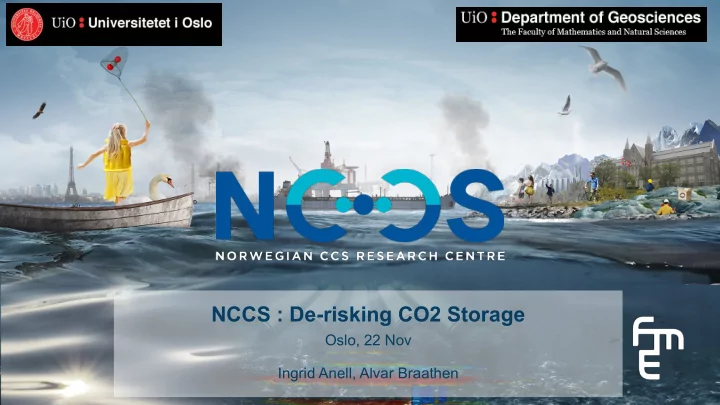

NCCS : De-risking CO2 Storage Oslo, 22 Nov Ingrid Anell, Alvar Braathen
NCCS project and Smeaheia storage DC 1 - CCS for Norwegian industry (0,5-1 Mt/a) DC 2 – Storing Europe’s CO2 (10-100 Mt/a) (From NCCS website)
Reducing atmospheric CO2 (1)Lowering the energy intensity of the system (i.e. increasing efficiency of energy conservation) (2)Lowering carbon intensity of system (substitution to lower C or C-free sources) (3)Increasing capacity and capture rate of carbon sinks
CO 2 Storage • 98% of transport and 85% of global energy comes from fossil fuels • CO2 in the atmosphere is increasing due to human activity • ”Carbon Sequestration” – physical, chemical, biological, technical • Increasing vegetation? Storing in oceans? Oil/gas trapped for millions of years: Inject CO2 in traps
Mudstone CO2 Storage (Seal) Traps Sandstone (Space)
CO2 Storage – why so deep? • Normal geotherm - > 800m, CO2 ”supercritical” – behaves like gas, density like a fluid • Optimum depth for “cold” basins is 800-1000 m and for “warm” basins it is 1500-2000m • Shallow depth - low density (inefficient storage) + high buoyancy (leakage potential) • 10-100 yrs – dissolve in pore-fluid • 100-1000 yrs– react with rock - mineralisation
NCCS – De-risking CO2 Storage Sequestration is defined as injection into a storage site without release for the foreseeable future. This is challenging on many levels with regards to finding sites, capturing, transporting and injecting CO2, and of great importance - ensuring minimal leakage and possible adverse effects of such an event. https://archive.epa.gov/ada/web/html/gsc.html
De-Risking CO2 Storage UiO Geo. Research Group • Structural de-risking – faults, relays, juxtaposition. Pressure systems and pockmarks. • Regional overburden analysis – risks and back-ups.
Research • Depositional models • Analogue systems
Aims and goals Longer term, toolbox aims: Longer term, toolbox aims: 1) Improved Smeaheia 1. Troll-Smeaheia advanced reservoir forecast reservoir to sim. model with 3D 2) Qualify satellite storage faults. formations 2. Improve geomechanical models that forecast fault reactivation Longer term, toolbox aims: into the 3D realm? 1. Establish aquifers- 3. Develop existing expert method aquitards for the for analysis of 3D fluid flow on overburden of the faults (requirements including software Smeaheia region development would be major efforts 2. Identify risks around exceeding NCCS?) shallow seals 3. Forecast fluid mobility in NCCS role vs NORCCS Operator work overburden succession 1) Discussion partner for Operator 4. Create pressure and flow 2) Toolbox developer forecast for overburden 3) Training of future experts
Recommend
More recommend